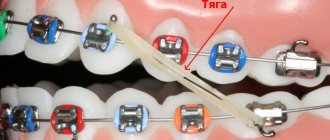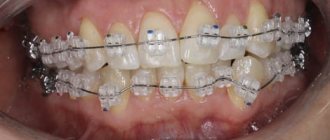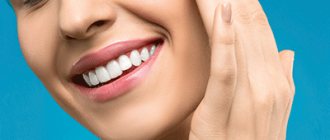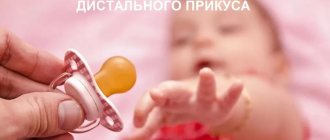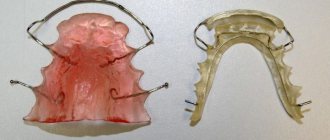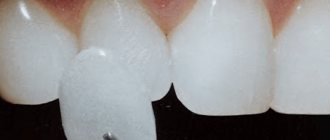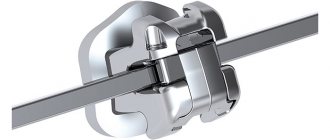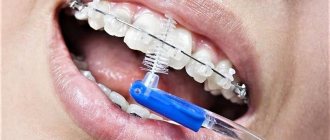Orthodontics as a branch of dentistry has become popular relatively recently. Two or three decades ago, the procedure for correcting malocclusion with braces was not particularly in demand, but now many people wear orthodontic structures on their teeth. Why you need to correct your bite and how to choose the right braces, orthodontists at the Lotus Dent dental clinic will tell you.
Bite correction: how long does it take?
Already at the beginning of treatment, the orthodontist will tell you how long you need to wear braces - the real and maximum period of correction. The average is 1.5-2.5 years. Treatment time depends on a number of factors:
- Age of the patient - for accelerated correction, braces are placed immediately after the appearance of the main teeth of the permanent dentition.
- Bite pathology - the difficulty of correcting anomalies in the dentofacial rows directly affects the duration of treatment.
- The type and material of the orthodontic apparatus - treatment takes place differently on lingual and vestibular braces, on bracket systems made of medical sapphires, ceramics, and metal.
Stages of treatment with braces
Correcting a bite with braces takes place in several stages:
- Preparation for orthodontic treatment - obtaining x-rays, OPTG, TRG and others. The doctor will also refer you for treatment of caries and pulpitis if he diagnoses signs of dental problems. Additionally, professional teeth cleaning and, in rare cases, removal of individual teeth are indicated.
- Fixation of the bracket system. The doctor will attach the plates under the arch on the patient’s teeth and install a wire of a suitable diameter and shape. During the treatment process, the orthodontist will gradually increase the diameter of the arches, and at the final stage, use a rigid rectangular wire.
- Removal of braces and retention period. The last stage is necessary to secure the position of the teeth in the correct positions. To do this, the patient is given a non-removable retainer on the sublingual side or night guards are prescribed.
The duration of treatment with braces depends on many factors - the complexity of the pathology being corrected, the anatomical characteristics of the patient, and the selected brace material.
Braces: wearing time depending on pathologies
How long to wear braces depends directly on your bite. Orthodontists use a special classification according to Engel, where anomalies of the dentofacial rows are divided into three groups.
The first class includes minor defects. Wearing braces can restore the correct bite in 6-12 months for pathologies:
- medium-sized diastema - a gap between the front teeth;
- crowding of the front incisors - there is not enough space for the permanent teeth due to the insufficient size of the dental arch;
- trema – interdental spaces remaining after a complete change of bite;
- transposition, dystopia - tooth eruption in the wrong place.
Rodikova Tatyana
Serious bite corrections require not only correction of the position of individual teeth, but also the formation of jaw arches. That is why the process is lengthy and requires the use of rigid orthodontic arches, elastics, and numerous techniques.
Correction of a bite with the listed anomalies is quick, especially at a young age and with the correct selection of a brace system. If we compare how long a 13-year-old child needs to wear braces and an almost adult 18-year-old patient, then the speed of treatment in the first case will be higher.
Long-term wearing of braces will require pathologies belonging to the second and third classes. Among them are the types of bite:
- distal – the lower jaw is underdeveloped, and the upper jaw is too large;
- mesial – there is underdevelopment of the upper jaw with a lack of size of the lower jaw;
- open - some of the teeth do not close, which increases the load on the rest;
- deep – the lower teeth are hidden under the upper ones, completely covered by them;
- cross - the incisors cross when the upper and lower jaws meet.
Correcting the listed problems is more difficult, so wearing braces requires two to three years, followed by consolidation of the result for another 4-5 years.
Why do braces change your appearance?
Not everyone knows that dental problems deform the face, adding asymmetry to it. Missing and long-term non-renewable teeth, malocclusion and periodontal diseases disrupt chewing function and overload individual teeth and facial muscles.
Aesthetic sapphire and ceramic braces, systematically correcting defects, strengthen the soft tissue framework, which includes skin, subcutaneous fat and muscles. Teeth moving into correct positions changes the position of the jaws and joints. As a result, muscles and ligaments are loaded evenly, sagging skin is tightened, and the fat underneath is redistributed.
Therefore, in parallel with the correction of dental anomalies, the shape of the face also changes. The degree of severity of the correction is determined by the individual characteristics of the dental system. But the accumulated experience and numerous photos before and after braces allowed specialists to formulate the general principles of the changes taking place.
How long do you wear braces made from different materials on average?
Initial appointments with an orthodontist are devoted to many questions: how long should a teenager wear braces and how to care for them, which system to choose and which material is preferable. At this stage, doctors immediately clarify the dependence of the duration of treatment on the material and type of bracket system:
- Metal braces. The main advantage of the metal structure is the creation of optimal pressure on the teeth. This feature guarantees the correction of even the most severe malocclusions. The average time for bite correction is 12-18 months.
- Plastic braces. They have minimal strength and the lowest cost. The duration of treatment is significant, but since the design is used to eliminate minor anomalies, patients wear polymer braces for 1-1.5 years.
- Ceramic braces. The system consists of ceramic plates in the color of enamel and a metal arc. The design is aesthetically pleasing, but fragile and does not provide the necessary pressure on pathologically located units. Not suitable for correcting serious defects. The period of wearing ceramic braces is up to 3 years.
- Sapphire braces. They have an aesthetic design, are unnoticeable, and functional. They eliminate not the most complex bite defects. The course of treatment is up to 3 years.
- Lingual braces. The design involves fixation on the inside of the teeth, which allows the use of metal without compromising aesthetics. Effective, discreet - suitable for children and adult patients. The correction period is moderate - up to 2.5 years.
Rodikova Tatyana
Teenage patients pay increased attention to aesthetics, which is why they choose ceramic braces. Metal ones are also popular, especially due to the ability to put colored rubber bands and thus express oneself.
Comparison of brace systems by duration of wearing
It is difficult to estimate the duration of wearing braces in absolute numbers. Doctors recommend systems taking into account the patient’s age and the complexity of the pathology - they select designs with a moderate duration of wear. But if you choose similar solutions to eliminate the same defect, where the duration of the correction will be shorter:
- Material. Metal is the preferred option and guarantees quick correction. In second place are ceramics, then sapphire braces and plastic ones.
- Place of fixation. Lingual braces are more effective than vestibular braces, but the latter are more comfortable to wear and more affordable.
- Ligature or self-ligating - from vestibular brace systems. Elastic ligatures help set the vector of maximum impact and provide the best point pressure on a tooth or a specific area. This strategy shortens treatment.
Changes in appearance: minus to minus gives a plus
On numerous forums you can find negative feedback about the ongoing changes in the face: “the cheeks are sunken”, “the skin is sagging”, “the face has aged”, etc. As a rule, such reviews are typical for the first two months of treatment with vestibular and lingual braces. Negative consequences are indeed observed during this period. And they are caused by two reasons:
- removal of teeth that interfere with the correction of the dentition;
- installation of a sufficiently voluminous orthodontic system that has a certain weight, immediately changing the appearance visually.
As a result, in the first weeks of treatment, many women panic because they:
- the face narrows;
- nasolabial folds deepen;
- if the upper jaw becomes heavier, the chin becomes sharper, and if the lower jaw becomes heavier, the cheeks become sunken;
- With some pathologies, the lips begin to bulge and it becomes difficult to close them.
Fortunately, the negative consequences will go away very quickly with the beginning of visible treatment progress. And already in the third or fourth month, facial features will begin to change for the better. Let's take a closer look at this process.
How long do teenagers wear braces?
The standard age for installing braces is 12-17 years. The physiology of the child’s body makes the speed of bite correction faster and the treatment more effective. The following factors contribute to reducing the period of wearing braces:
- complete change of bite;
- eruption of second molars;
- the end of the formation of the dental system and the muscular-ligamentous apparatus while maintaining their good mobility.
The bone tissue of adolescents is plastic and quickly responds to mechanical pressure, which allows teeth to be shifted to an anatomically correct position.
Soldatenkova Alina
I am often asked how long to wear braces for a 13-year-old teenager. The average time for bite correction is 1-1.5 years. But each case is individual.
When can you remove braces?
The process of occlusion correction consists of several stages; the structures can be removed after completion of the last one. First, the teeth are aligned along the arch, then the main formation of the bite occurs (the teeth are moved forward or backward, gaps are removed, the position of the jaws is corrected), and finally minor defects are eliminated. An orthodontist removes braces in a dental office.
In some cases, braces have to be removed ahead of schedule:
- - development of inflammatory processes in the oral cavity;
- - allergic reaction to elements of the system (most often to metal);
- - poor oral hygiene;
- - the need for surgery to correct the bite.
If possible, after removing the treatment limitation, the system is reinstalled. Otherwise, an alternative method of orthodontic treatment is selected.
Wearing braces: average time, minimum, maximum
Children's orthodontists have long collected statistics on how long it takes from fixation to removal of braces:
- quick treatment – six months to a year;
- the average for severe anomalies is 1-2.5 years;
- the maximum period (registered record) is more than 9 years.
Every year the complexity and duration of treatment increases. Correcting the same pathology at 27 years old will require almost a year more time than at 18 years old.
What factors affect wearing time?
- 1. Age. Bone tissue and ligaments in adolescents are more plastic, so eliminating bite problems of any complexity before the age of 18 requires an average of 3-6 months less time. This does not mean that complex defects cannot be corrected for an adult, but more time will have to be spent.
- 2. Complexity of the defect. The severity of the anomaly and its type also affect the timing of treatment. Even the most advanced cases of crowding are corrected faster than problems with jaw closure.
- 3. Type of system. The material and design of braces affect the timing. Non-ligature metal structures are the fastest to correct. Lingual ones take the longest, but they are invisible.
- 4. Doctor's experience. Optimal selection of the system, correct installation, control of tooth displacement - parameters that depend on the experience of the orthodontist. In our clinic, doctors are constantly improving their skills, so they can correct your bite in a minimum amount of time.
- 5. Patient compliance with recommendations. Following a diet and proper care of systems are also important. Damage to structures and the development of caries can cause a suspension of correction or a decrease in the effectiveness of treatment.
How to speed up treatment with braces
All patients can delay the time of braces removal. To do this, you must comply with the requirements of the pediatric orthodontist:
- Come to scheduled appointments. An appointment is more than just an examination. When communicating with the patient, the doctor evaluates the dynamics, changes ligatures and arches, and selects elastics for enhanced correction.
- Monitor the integrity of the system. If the ligatures break, the bracket comes off, or the orthodontic arch falls out, the patient needs to urgently consult a doctor to restore the structure.
- Change elastics according to schedule. At a certain stage of correction, the orthodontist strengthens the work of braces with the help of elastic bands. At home, the patient must change elastics every 12 hours - independently and without skipping.
Wearing braces is an effective way to correct the position of teeth and bite characteristics. Following the orthodontist's recommendations will help you get rid of crooked teeth, protruding or receding jaws - make your teeth straight and beautiful.
The principle of operation of the braces system
So, how do dental braces work? The main corrective link is the orthodontic arch. After X-ray diagnostics and determination of the ideal bite for a particular patient, the doctor makes calculations and selects an arch of the desired shape and cross-section.
During the correction process, the orthodontic arch tends to the shape specified by the orthodontist and pulls the parts fixed on it - locks, springs. And since the bracket is attached to each tooth, the teeth also move.
To maintain the strength and functionality of the structure, the doctor periodically replaces the weakened arch with a new one. In the first stages, the thinnest wire is used, gradually increasing the thickness.
What consequences can there be from an incorrect bite?
An incorrect bite negatively affects a person’s health if it is not corrected in time. Abrasion of the tooth edges may occur, and diction may be impaired. Pieces of food get stuck in the spaces between improperly growing teeth, and this is a direct path to the development of caries.
In addition to physiological problems, changes in the oval of the face also occur due to malocclusion. Due to the displacement of the lower jaw, horizontal asymmetry, hollowing or sagging of the cheeks may occur. The line of the mouth also changes - the corners of the lips droop, they become thinner, and do not close completely. The face is changing, and only clinical intervention will save the situation.
Call us and make an appointment!
Whatever models of braces are used, the result of bite correction directly depends on the qualifications and practical experience of the specialist. Since installing any system requires a thorough diagnosis and preliminary calculations, the professional skills of an orthodontist are extremely important. It is the specialist who determines the most effective method for correcting the anomaly, and also calculates the pressure with which the teeth should move.
Orthodontist Irina Aleksandrovna Butorina has extensive practical experience in the treatment of any malocclusion disorders and knows the most innovative correction methods. By making an appointment, you will be able to verify her competence from personal experience, and if you follow all the specialist’s recommendations, you will get an excellent result and a flawless smile.
Contact us and forget about complexes, inconveniences in communicating with others and possible health problems. Make an appointment and come see your bite corrected with braces for adults professionally!
Classic vestibular braces
They are also external braces - the most common. These braces are fixed on the outer surface of the teeth, the one we see when we smile.
Vestibular braces are the most popular system for correcting malocclusion, but they are not the only one, including for adults.
Ligature braces (the arch is secured with special rubber bands - ligatures)
Advantages of external braces in the treatment of malocclusion:
- This is the most functional device that we can use in adults. Corrects all possible malocclusions. If the case is complex and surgery is needed, braces are worn before or after it. In addition, they can be supplemented: install springs, rods, buttons, ligatures, chains for pulling out impacted teeth. The more complex the pathology, the greater the likelihood that something additional will need to be tightened, and this is where such a wide functionality of braces comes in handy.
Example: a spring connects the braces and forms the bite
- The second plus is a consequence of the first: braces provide the maximum effect of expanding the dentition. If the row is significantly narrowed compared to the norm, braces are most preferable. In addition, the narrowing of the dentition is most often accompanied by the absence of some teeth (that is, they are there, but are located inside the gums - they remain impacted). And pulling out impacted teeth using an arch of braces is justified and convenient.
- Price. You can choose to suit any budget. Expensive - transparent sapphire and for a relatively small amount - metal. Visually they are less attractive, but no worse in efficiency.
Aesthetic ceramic braces are less noticeable.
External braces also have disadvantages. Moreover, they are the same for any system, both the simplest metal one and the aesthetic one with white or transparent braces.
- Any external braces, even white-painted arches, are still noticeable. And this often influences the choice: not all adults are ready to wear them. Although no one is surprised by braces for a long time, and no one pays attention to them, for many it is still a psychological barrier.
- It is more difficult to maintain hygiene. Although adult patients usually take a conscious approach to treatment and follow all recommendations, force majeure nevertheless occurs: trips on vacation or a business trip, where there is no time or it is inconvenient to constantly brush your teeth after eating. Braces are a non-removable structure, you have to eat with them, and leftover food remains on them. You have to spend about 20 minutes on each brushing (about an hour a day in total), otherwise plaque will form, which increases the risk of developing caries. Braces themselves do not cause caries and do not spoil the enamel - plaque damage due to poor hygiene does.
- Wearing braces hurts. Although this is subjective, it all depends on the individual and pain threshold. In the first days after activation of the system (it is carried out every month), some patients sometimes have to take pain medication. In addition, the protruding parts of the braces can scratch the oral mucosa and rub it. For most patients, this goes away within a few days, while others experience discomfort from such side effects throughout the entire treatment period. But you can seal the protruding areas of the braces with orthodontic wax.
This is what braces with protective wax look like
- You are not allowed to eat all foods with braces, even after the pain subsides. Avoid solid foods - hard fruits and vegetables, nuts. Chewing meat also becomes difficult, as fibers become clogged in the space between the teeth and the arch. The fact that you will have to eat food pureed through a blender for a year is an exaggeration, but you can forget about some delicacies for a year and a half.
Braces are effective for treating adults, but you have to come to terms with the shortcomings of this technology. Spend a lot of time taking care of your teeth, limit yourself to certain dishes, get used to your smile with “decoration”.
Contraindications for installing braces
Even if there are indications for orthodontic correction using a brace system, it happens that such therapy may be contraindicated for a particular patient. Prohibitions are divided into relative and absolute. Relative restrictions include those that are temporary, for example, the acute course of a disease.
Relative contraindications:
- periodontal diseases;
- dental diseases (caries, pulpitis, etc.);
- pregnancy;
- bruxism.
Absolute contraindications:
- partial edentia (absence of a large number of teeth);
- oncology;
- osteoporosis and other bone diseases;
- mental illness;
- endocrine diseases;
- HIV AIDS;
- tuberculosis.
